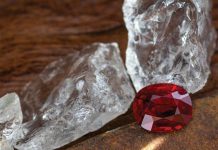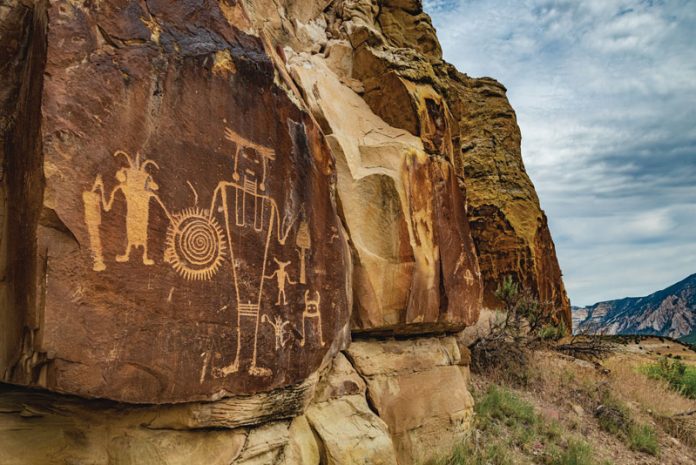
Why were petroglyphs made? Although the images vary in age and style from one part of the West to the next, they all show the same expert ability to peck distinct pictures in stone. Yet the reason they were created is up for debate.
It was a sunny afternoon in November when I first took in the astounding beauty of Renegade Canyon. Located within the highly guarded China Lake Naval Air Weapons Station in the California Desert, the canyon features thousands of petroglyphs etched on its sheer rock walls. I was privileged to be part of a group that was allowed to tour the canyon that day, an event that only happens a few times per year.
While Renegade Canyon is home to the largest concentration of ancient petroglyphs in North America, similar images etched in stone can be found throughout the deserts of the West. Ranging in age from 200 to 16,000 years old, the petroglyphs of the West are as mysterious as they are beautiful.
Sacred Drawings
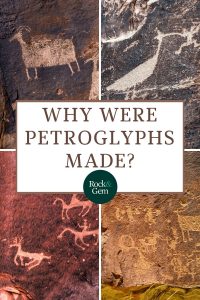
Experts have long tried to interpret the meaning of the drawings left behind by the ancient indigenous people of the West. Images of animals, humans and abstract shapes can be found in rocky deserts not only in California but also in Arizona, New Mexico, Utah and Nevada.
“Rock art all over the world is, in great part, the result of indigenous people who did not possess a written language,” says Dr. Alan Garfinkel, founder and president of the California Rock Art Foundation.
“The images on stone are best likened to a codex or a set of symbols that communicate thoughts, feelings, messages and sacred narratives. They also serve as visual prayers, memory palaces and perpetual memorials for individuals and groups living within the vicinity of the rock art sites.”
Dr. Garfinkel adds that although petroglyphs are commonly referred to as rock art, Native people do not like the images on stone referred to as art.
“They do not feel this is ‘art’ as non-Indians define it,” he says. “The images are meant to be religious symbols full of power and sacredness.”
Shaman-Created Images
The theory that shamans created these images thousands of years ago as part of a spiritual ritual is widely accepted by many experts.
“Shamans are religious functionaries that were responsible for connecting or being the liaison from the terrestrial to the celestial worlds, from the mundane to the supernatural, from the conventional to the supernatural,” says Dr. Garfinkel. “They brought down the rain, they communicated with the deities and the shamanistic ancestor deities of the spirit world. They were—and are—the healers, the Native doctors.”
Compelling evidence exists to support the idea that shamans were the principal “artists” who drew the images on stone, according to Dr. Garfinkel.
“These images were in part meant to memorialize their dreams, visions and the messages they received from the spirit world when in trance.”
When looking at the various images etched into stone, it’s easy to see the connection to dreams and visions. While some petroglyphs represent common elements of reality such as bighorn sheep, snakes and the sun, others appear to be abstract. Part animal/part human figures can be seen, along with random geometric shapes and patterns. While otherworldly creatures can be the stuff of sleeping dreams, visions of geometric shapes and patterns have been reported by modern humans have entered into trancelike states.
While we can surmise the images have a sacred significance, their exact meaning remains elusive. “It is difficult to get into the mind of the original artist that produced the images we see incised in stone, and this situation exists for a number of reasons,” says Dr. Garfinkel. “The cognition and cultural values of an artisan centuries and millennia ago is certainly very different from anything we might imagine for ourselves as members of a 21st-century western industrial society.”
Stone Canvas
Petroglyphs by definition are images etched into stone, rather than painted. The geological elements present in Western deserts created a virtual canvas for ancient artists.
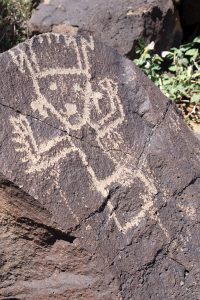
Traveller70/Shutterstock
Petroglyphs are found on a variety of different types of sedimentary stone typically seen in the desert, including basalt, limestone and granite. What each of these rocks surfaces share when petroglyphs are present is a coating of “desert varnish.” A red-to-black veneer found on exposed rock surfaces in arid environments, it is composed of clay minerals, oxides and hydroxides of manganese or iron. Desert varnish takes thousands of years to form, so it is only seen on rocks that do not easily erode.
Ancient artists created their images by pecking away at the desert varnish, exposing the lighter rock underneath. Until recently, scientists weren’t sure what type of rock was being used to chip away at the desert varnish. But recent research has shown that all petroglyph surfaces containing remnants of the stone used to remove the desert varnish were created using quartz. Because quartz is believed to have powerful energy by indigenous people of the region, it makes sense it would have been used as the hammerstone to create spiritual imagery.
Determining the age of a petroglyph means using qualitative and technical methods of dating. The qualitative method uses the content of the drawings to rule out older periods, while the technical method employs radiocarbon measurements, X-ray fluorescence, cation-ratio dating of the varnish and other scientific techniques. Using these techniques, some petroglyphs have been estimated to be as old as the Ice Age. Images that show more recent phenomena like a rider on horseback are dated back to the 16th century when Spaniards first appeared in the Southwestern U.S.
Popular Images
Although petroglyphs show much variety around the West, some images are more common than others and even easier to interpret. By looking at what modern indigenous people of the region have retained of their ancient culture, ethnologists can make sense of the images seen in the petroglyphs.
One such image is the encircled or boxed cross, which is found in petroglyphs throughout the Americas.
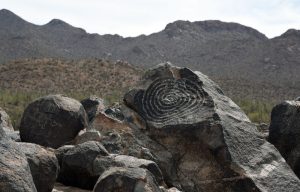
Nature’s Charm/Shutterstock
“It has celestial meaning in representing the morning and evening star. The star is the planet we know as Venus [which appears either at sunrise or sunset, depending on the time of year], yet aboriginal people knew it as two different stars. These stars were the personifications of celestial, supernatural beings. The cross and its four staffs are meant to also represent the four cardinal directions, and the four basic elements of the universe: earth, wind, fire and water.”
Animal Petroglyphs
The bighorn sheep is another widely seen image in petroglyphs and is one of the most common symbols found throughout the desert west.
“On a common level, we know these creatures,” says Dr. Garfinkel. “They are majestic and remarkable animals. To the Native people, the sheep were at one level food. They would hunt these creatures for their meat, and they were in fact a tasty treat, and one that was revered for its valuable meat and for its skin.”
The bighorn sheep was also perceived as a symbol of rain, good health, and sacred and religious prestige. According to Garfinkel, the bighorn was the shamanistic boss of the large game animals.
“The horns of this sheep are impressive, and native people perceived these animals as extremely powerful and able to perform almost magical or supernatural moves as they climbed up near-vertical shelves of stone,” he says. “They lived in the uppermost strata at the tops of mountains, which made them even more sacred, holy and religiously powerful.”
The thunderbird is another common figure seen in petroglyphs and is known throughout California, the Great Basin, the Plains and even Eastern North America.
“The thunderbird is perceived as an image, and meant to remind us of an offering for rain and water for life,” says Dr. Garfinkel. “Also for the hope of power and strength akin to the eagle, with even greater magic to produce lightning and thunder. Since the thunderbird is an avian creature of the sky, it is considered one of the most powerful and sacred of the religious beings.”
Another frequently seen image in petroglyphs is the atlatl, an ancient hunting weapon used by humans well before our species found its way to the Americas. Represented as a circle with a spear, the atlatl was used to hunt large game, such as the bighorn sheep. It was eventually replaced with the bow and arrow, which is also depicted in later etchings.
Preserving Petroglyphs
Over the past hundred years, petroglyphs throughout the West have been destroyed through vandalism. This has motivated those who treasure these ancient images to strive to protect them.
The petroglyphs of Renegade Canyon are preserved because of their location on the China Lake Naval Base, and can only be viewed on rare guided tours. But in parks and monuments around the West, petroglyphs are both protected and available for viewing by the public.
Valley of Fire State Park in Nevada, less than an hour from Las Vegas, is home to a spectacular array of petroglyphs that can be seen by car or on foot. Dinosaur National Monument, Arches National Park, Newspaper Rock State Historic Park and Nine Mile Canyon, all in Utah, have petroglyphs in areas open for viewing. In Arizona, Petrified Forest National Park is home to a large tableau of etched images. And Petroglyph National Monument in New Mexico, within the city limits of Albuquerque, is open for hiking while viewing the rocks.
These are only a few places where petroglyphs can be easily seen and appreciated. Because this ancient art is common throughout the West, you may even stumble upon some images on a hike in the desert. If you do, be sure to pause and honor the ancient artists who created them.
This story about why were petroglyphs made previously appeared in Rock & Gem magazine. Click here to subscribe! Story by Audrey Pavia.


